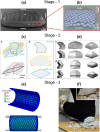A Review of Image-Based Simulation Applications in High-Value Manufacturing
- PMID: 36685137
- PMCID: PMC9847465
- DOI: 10.1007/s11831-022-09836-2
A Review of Image-Based Simulation Applications in High-Value Manufacturing
Abstract
Image-Based Simulation (IBSim) is the process by which a digital representation of a real geometry is generated from image data for the purpose of performing a simulation with greater accuracy than with idealised Computer Aided Design (CAD) based simulations. Whilst IBSim originates in the biomedical field, the wider adoption of imaging for non-destructive testing and evaluation (NDT/NDE) within the High-Value Manufacturing (HVM) sector has allowed wider use of IBSim in recent years. IBSim is invaluable in scenarios where there exists a non-negligible variation between the 'as designed' and 'as manufactured' state of parts. It has also been used for characterisation of geometries too complex to accurately draw with CAD. IBSim simulations are unique to the geometry being imaged, therefore it is possible to perform part-specific virtual testing within batches of manufactured parts. This novel review presents the applications of IBSim within HVM, whereby HVM is the value provided by a manufactured part (or conversely the potential cost should the part fail) rather than the actual cost of manufacturing the part itself. Examples include fibre and aggregate composite materials, additive manufacturing, foams, and interface bonding such as welding. This review is divided into the following sections: Material Characterisation; Characterisation of Manufacturing Techniques; Impact of Deviations from Idealised Design Geometry on Product Design and Performance; Customisation and Personalisation of Products; IBSim in Biomimicry. Finally, conclusions are drawn, and observations made on future trends based on the current state of the literature.
© The Author(s) 2023.
Figures






































References
-
- Withers PJ, Bouman C, Carmignato S, Cnudde V, Grimaldi D, Hagen CK, Maire E, Manley M, Du Plessis A, Stock SR. X-ray computed tomography. Nat Rev Methods Primers. 2021;1:1–21. doi: 10.1038/s43586-021-00015-4. - DOI
-
- Schlüter S, Sheppard A, Brown K, Wildenschild D. Image processing of multiphase images obtained via X-ray microtomography: a review. Water Resour Res. 2014;50:3615–3639. doi: 10.1002/2014WR015256. - DOI
-
- Rizwan I, Haque I, Neubert J. Deep learning approaches to biomedical image segmentation. Inform Med Unlocke. 2020;18:100297. doi: 10.1016/j.imu.2020.100297. - DOI
-
- Livesey F (2006) Confederation of British Industry, University of Cambridge, Institute for Manufacturing, Defining high value manufacturing, CBI, London. http://www.cbi.org.uk/ndbs/positiondoc.nsf/1f08ec61711f29768025672a0055f.... Accessed 7 Apr 2022.
Publication types
LinkOut - more resources
Full Text Sources
Miscellaneous
